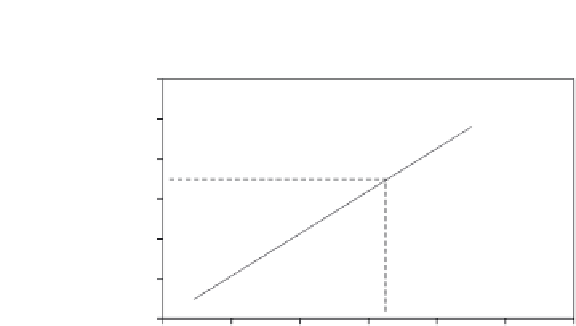Biomedical Engineering Reference
In-Depth Information
3.0
p
m
(GPa)
2.5
2.0
p
m, Y
1.5
1.0
0.5
0.0
rep
(%)
0.0
0.2
0.4
0.6
0.8
1.2
FIGURE 17.4
Mean contact pressure
p
m
as a function of representative
strain
rep
in enamel - a schematic;
p
m,Y
denotes the
onset of irreversible deformations.
surface. With increasing load, this volume grows, together with
p
m
, but the load-displacement curve
is influenced much later
[18]
, for
p
m
1
.
6
σ
Y
. Nevertheless, the yield contact pressure,
p
mY
, may also
be used as a material characteristic.
The onset of irreversible processes can also be revealed
[16]
from the diagram showing the ratio
h
c
/
h
as a function of mean contact pressure
p
m
. For elastic deformations and spherical indenter,
h
c
/
h
0.5,
while for elastic-plastic deformations
h
c
/
h
0.5. The yield contact pressure
p
mY
corresponds to the
point from which the ratio
h
c
/
h
starts growing
[16]
.
17.4
DETERMINATION OF PROPERTIES IN NONHOMOGENEOUS BODIES
Foods and drinks act chemically on enamel and can change its mechanical properties in a thin surface
layer. Changes are also caused by various treatment, such as teeth whitening. Surface modifications
or special coatings are used to improve the properties of components for restorative dentistry. Another
problem is the study of materials consisting of several phases, such as enamel (tiny hard hydroxyapa-
tite rods surrounded by softer organic matter) or polymeric resins with a filler in form of small par-
ticles. Nanoindentation can provide quantitative information about mechanical properties in all these
cases. However, the preparation and evaluation of the measurements must consider that the obtained
values (e.g., hardness) are influenced not only by the properties of the small indented volume, but
also by the material around it.
17.4.1
Surface Layers and Coatings
The situation is simple if the change of properties is gradual
[20]
, caused, e.g., by chemical action of
a drink or some surface treatment. The first information is obtained by making several tests with vari-
ous loads, and plotting the measured quantity as a function of depth, e.g.,
H
(
h
) or
E
(
h
), generally
X
(
h
).













